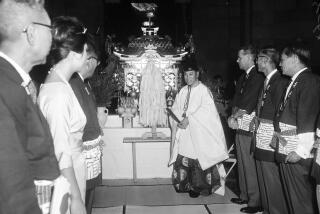Controversy Casts Cloud Over a Moment in the Sun
Even when something good happens in Bell Gardens, something bad follows.
When an elegant monument honoring Latino war heroes was unveiled during Memorial Day weekend, the city--more used to being in the spotlight because of its history of scandalous politics--basked in rare positive media coverage.
But even that has turned a bit sour.
Over the weekend, the City Council ordered a plaque bearing the name of City Manager Maria Chacon--currently being investigated by the Los Angeles County district attorney’s office for possible corruption--to be taken down.
The decision was made after complaints in the community and within the council itself that the monument seemed to glorify Chacon--whose name appeared on the monument in three places.
A few Bell Gardens residents also have complained that the plaque that was removed should have been in English, rather than Spanish, and that the focus on Latino heroes was not inclusive of all soldiers.
To be sure, much of the noise is coming from political enemies of Chacon, who protested even at the unveiling of the monument.
“She’s glorifying herself at the cost of all residents,” said Jenny Rodriguez, daughter of Rogelio Rodriguez, who lost his City Council seat in March.
Some say the negative reaction is taking away from the noble intention of the project.
“Regrettably, we like to criticize instead of focusing on the positive,” said Mayor Ramiro Morales.
The Hispanic American Veterans Memorial is an 80-foot-wide, 20-foot-high statue of a fallen soldier in the arms of an angel. It was meant to honor 39 Latino winners of the Medal of Honor, but is also dedicated to all the recipients of the medal, the nation’s highest military honor.
The unveiling was a moment in the sun for the blue-collar city with a history of bitter recalls and arrests of council members. Most recently, the district attorney has been investigating whether Chacon, a former council member, broke the law by casting several votes that paved the way for her to be appointed city manager.
Whispers began at the unveiling when Chacon’s name was found in three places on it.
One spot where it appears on is the principal plaque, which traditionally has the names of elected officials. Another--the one removed--was the official artist dedication, which starts: “It was a beautiful dream of Mrs. Maria S. Chacon . . . “
Her name is also engraved near the sculptor’s signature.
The idea for the monument was indeed Chacon’s, when she was mayor pro tem last fall.
Sculptor Alfredo O. Osorio said that Chacon--whose idea was approved by the council--talked about creating a monument as a positive influence for local youth as a deterrent to gangs.
“She was the intellectual author of the monument,” said Osorio, whose Hawthorne studio was visited by Chacon, Morales and even Rogelio Rodriguez, who was then still on the council.
Osorio said the dedication plaque that praises Chacon was meant as a gift to her to show his gratitude for her support of the project. He engraved her name next to his as a similar gesture, he said.
Chacon has said she did not know about the two personal gestures--which were not approved by the City Council--although Osorio wrote a letter to her with the text of what the dedication plaque would say.
Osorio said the attacks on Chacon are unwarranted. “A horrible injustice is being committed,” he said, adding that he is “indignant” about the removal of his dedication.
But Chacon’s critics point to another questionable naming of a city-sponsored project.
A new recreational facility, Ricky’s Skate Park--which Chacon was instrumental in developing--is named after her son. Not many in town--not even some within City Hall--know how the park was named.
Chacon says the idea for the park originated during a trip with her son to Phoenix, where the two visited a skating facility. She and her son, Chacon said, gathered information on building a similar facility in their town.
“We have parks with no names,” Chacon said, adding that the naming of the skating facility was approved by the City Council. “What is the big deal?”
Another complaint about the military monument has been that it focuses on Latino heroes at the exclusion of others.
“A soldier doesn’t have color or race,” said Rogelio Rodriguez. He denies that, as a council member, he approved the current monument because it originally didn’t have the Latino theme.
Lost in the negativity, Osorio said, is the message of the Latino servicemen for today’s youth.
“They died giving a good example to our race,” he said.
More to Read
Sign up for Essential California
The most important California stories and recommendations in your inbox every morning.
You may occasionally receive promotional content from the Los Angeles Times.










